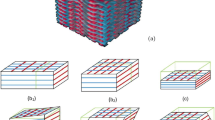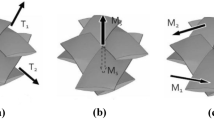Abstract
The clear multi-scale structure of composite textile reinforcements leads to develop continuous and discrete approaches for their forming simulations. In this paper two continuous modelling respectively based on a hypoelastic and hyperelastic constitutive model are presented. A discrete approach is also considered in which each yarn is modelled by shell finite elements and where the contact with friction and possible sliding between the yarns are taken into account. Finally the semi-discrete approach is presented in which the shell finite element interpolation involves continuity of the displacement field but where the internal virtual work is obtained as the sum of tension, in-plane shear and bending ones of all the woven unit cells within the element. The advantages and drawbacks of the different approaches are discussed.












Similar content being viewed by others
References
Advani SG (1994) Flow and rheology in polymeric composites manufacturing. Elsevier, Amsterdam
Saouab A, Bréard J, Lory P, Gardarein B, Bouquet G (2001) Injection simulations of thick composite parts manufactured by the RTM process. Compos Sci Technol 61:445–451
Mouritz AP, Bannister MK, Falzon PJ, Leong KH (1999) Review of applications for advanced three-dimensional fibre textile composites. Compos Part A 30:1445–1461
de Luycker E, Morestin F, Boisse P, Marsal D (2009) Simulation of 3D interlock composite preforming. Compos Struct 88:615–623
Tong L, Mouritz AP, Bannister MK (2002) 3D Fibre reinforced polymer composites. Elsevier Science, Oxford
Creech G, Pickett AK (2006) Meso-modelling of non-crimp fabric composites for coupled drape and failure analysis. J Mater Sci 41:6725–6736
Boisse P, Gasser A, Hagège B, Billoet JL (2005) Analysis of the mechanical behavior of woven fibrous material using virtual tests at the unit cell level. J Mater Sci 40:5955–5962
Dong L, Lekakou C, Bader MG (2001) Processing of composites: simulations of the draping of fabrics with updated material behaviour law. J Compos Mater 35:138–163
Hagège B, Boisse P, Billoët JL (2005) Finite element analyses of knitted composite reinforcement at large strain. European Journal of Computational Mechanics 14:767–776
Peng X, Cao J (2005) A continuum mechanics-based non-orthogonal constitutive model for woven composite fabrics. Compos Part A 36:859–874
Rogers TG (1989) Rheological characterisation of anisotropic materials. Composites 20:21–27
Spencer AJM (2000) Theory of fabric-reinforced viscous fluids. Compos Part A 31:1311–1321
ten Thije RHW, Akkerman R, Huétink J (2007) Large deformation simulation of anisotropic material using an updated Lagrangian finite element method. Comput Methods Appl Mech Eng 196:3141–3150
Yu WR, Pourboghrata F, Chungb K, Zampaloni M, Kang TJ (2002) Non-orthogonal constitutive equation for woven fabric reinforced thermoplastic composites. Compos Part A 33:1095–1105
Ben Boukaber B, Haussy G, Ganghoffer JF (2007) Discrete models of woven structures. Macroscopic approach. Compos Part B 38:498–505
Duhovic M, Bhattacharyya D (2006) Simulating the deformation mechanisms of knitted fabric composites. Compos Part A 37:1897–1915
Pickett AK, Creech G, de Luca P (2005) Simplified and advanced simulation methods for prediction of fabric draping. European Journal of Computational Mechanics 14:677–691
Zhou G, Sun X, Wang Y (2004) Multi-chain digital element analysis in textile mechanics. Compos Sci Technol 64:239–244
Durville D (2005) Numerical simulation of entangled materials mechanical properties. J Mater Sci 40:5941–5948
Durville D (2008) A finite element approach of the behaviour of woven materials at microscopic scale—11th Euromech-Mecamat conference—Mechanics of microstructured solids: cellular materials, fiber reinforced solids and soft tissues, Torino, Italia. arXiv:0804.2952v1 [cond-mat.soft]
Miao Y, Zhou E, Wang Y, Cheeseman BA (2008) Mechanics of textile composites: micro-geometry. Compos Sci Technol 68:1671–1678
Truesdell C (1955) Hypo-elasticity. J Ration Mech Anal 4:83–133
Xiao H, Bruhns OT, Meyers A (1998) On objective corotational rates and their defining spin tensors. Int J Solids Struct 35:4001–4014
Belytschko T, Liu WK, Moran B (2000) Nonlinear finite elements for continua and structures. Wiley, Chichester
Crisfield MA (1997) Non-linear finite element analysis of solids and structures. Wiley, Chichester
Badel P, Gauthier S, Vidal-Sallé E, Boisse P (2008) Rate constitutive equations for computational analyses of textile composite reinforcement mechanical behaviour during forming. Compos Part A. doi:10.1016/j.compositesa.2008.04.015
Hughes TJR, Winget J (1980) Finite rotation effects in numerical integration of rate constitutive equations arising in large deformation analysis. Int J Numer Methods Eng 15:1862–1867
Khan MA, Mabrouki T, Boisse P (2009) Numerical and experimental forming analysis of woven Composites with double dome benchmark. Proceedings Esaform 2009, Springer
Khan MA (2009) Numerical and experimental analyses of woven composite reinforcement draping using a hypoelastic behaviour. Ph.D. Thesis, INSA Lyon
Woven composites benchmark forum. http://www.wovencomposites.org/. Accessed 11 May 2009
Cao J, Akkerman R, Boisse P, Chen J et al (2008) Characterization of mechanical behavior of woven fabrics: experimental methods and benchmark results. Compos Part A 39:1037–1053
Lomov SV, Boisse P, De Luycker E, Morestin F, Vanclooster K, Vandepitte D, Verpoest I, Willems A (2008) Full-field strain measurements in textile deformability studies. Compos Part A 39:1232–1244
Buet-Gautier K, Boisse P (2001) Experimental analysis and modeling of biaxial mechanical behavior of woven composite reinforcements. Exp Mech 41:260–269
Spencer AJM (1984) Continuum theory of the mechanics of fibres-reinforced composites. Springer-Verlag, New York
Basar Y, Weichert D (2000) Nonlinear continuum mechanics of solids. Springer, Berlin
Ogden RW (1984) Non-linear elastic deformations. Wiley, New York
Truesdell C, Noll W (1965) The nonlinear field theories of mechanics. Edition Handbuch der Physik Vol. III. Spinger, Berlin
Aimène Y, Vidal-Sallé E, Hagège B, Sidoroff F, Boisse P (2009) A hyperelastic approach for composite reinforcement large deformation analysis. J Compos Mater. doi:10.1177/0021998309345348
Daniel JL, Soulat D, Dumont F, Zouari B, Boisse P, Long AC (2003) Forming simulation of very unbalanced woven composite reinforcements. Int J Form Process 6:465–480
Dumont F (2003) Expérimentations et modèles de comportement de renforts de composites tissés. Ph.D. Thesis, Paris VI University
Dridi S (2009) Modélisation du comportement mécanique des textiles par des lois hyperélastiques. Ph.D. Thesis, University of Monastir and INSA Lyon, to appear
Badel P, Vidal-Sallé E, Maire E, Boisse P (2009) Simulation and tomography analysis of textile composite reinforcement deformation at the mesoscopic scale. Compos Sci Technol 68:2433–2440
Grave G, Birkefeld K, von Reden T, Drechsler K, Kyosev Y, Rathjens A (2009) Simulation of 3D overbraiding—solutions and challenges. Second World Conference on 3D Fabrics and their Applications, Greenville
Nilakantan G, Keefe M, Gillespie JW, Bogetti TA (2009) Simulating the impact of multi-layer fabric targets using a multi-scale model and the finite element method. Recent advances in textile composites. Proceedings of the 9th International Conference on Textile Composites—TEXCOMP9), DEStech Publications, Inc., 506–515
Sapozhnikov SB, Forental MV, Dolganina NY (2007) Improved methodology for ballistic limit and blunt trauma estimation for use with hybrid metal/textile body armor. Proceedings of the Conference Finite element modelling of textiles and textile composites (CD ROM), St-Petersburg
Boisse P, Zouari B, Daniel JL (2006) Importance of in-plane shear rigidity in finite element analyses of woven fabric composite preforming. Compos Part A 37:2201–2212
Hamila N, Boisse P, Sabourin F, Brunet M (2009) A semi-discrete shell finite element for textile composite reinforcement forming simulation. Int J Numer Methods Eng 79(12):1443–1466
Prodromou AG, Chen J (1997) On the relationship between shear angle and wrinkling of textile composite preforms. Compos Part A 28:491–503
de Bilbao E, Soulat D, Hivet G, Launay J, Gasser A (2008) Bending test of composite reinforcements. International Journal of Material Forming. doi:10.1007/s12289-008-0265-z
Launay J, Hivet G, Duong AV, Boisse P (2008) Experimental analysis of the influence of tensions on in plane shear behaviour of woven composite reinforcements. Compos Sci Technol 68:506–515
Lomov SV, Verpoest I (2006) Model of shear of woven fabric and parametric description of shear resistance of glass woven reinforcements. Compos Sci Technol 66:919–933
Sabourin F, Brunet M (1995) Analyses of plates and shells with a simplified 3 node triangular element. Thin-walled Struct 21:238–251
Onate E, Zarate F (2000) Rotation-free triangular plate and shell elements. Int Numer Methods Eng 47:557–603
Allaoui S, Boisse P, Chatel S, Hamila N, Hivet G, Soulat D (2009) Experimental and numerical analysis of a woven reinforcement forming process. Compos Part B, submitted
Hamila N, Boisse P, Chatel S (2008) Finite element simulation of composite reinforcement draping using a three node semi discrete triangle. International Journal of Material Forming 1:867–870. doi:10.1007/s12289-008-0-273-z
Author information
Authors and Affiliations
Corresponding author
Appendix A
Appendix A
γ is the shear angle, γ = θ1–θ2 (Fig. 3). It is shown that a shear angle increment dγ gives stresses proportional to Gdγ in the stress computation scheme presented “Continuous approach 1: a hypoelastic model” (Eq. 3 to 11). That is important because the in-plane shear behaviour of a textile material is function of the shear angle (G is not a constant and depends on γ).
The polar rotation tensor and deformation gradient tensor are respectively:
\( {\lambda_\beta } \) is the deformed length of an initially unit fibre in the direction β. The right stretch tensor \( \underline{\underline {\mathbf{U}}} \) is given by the polar decomposition:
The symmetry of \( \underline{\underline {\mathbf{U}}} \) imposes
In the case of pure in plane shear (λ1 = λ2 = 1) or in the case of equal fibre elongations in warp weft directions, this equation becomes
In the case of most of the composite reinforcements, the fibre elongations are small and (31) can be considered.
Because the frames (\( {\underline {\mathbf{e}}_1},{\underline {\mathbf{e}}_2} \)), (\( {\underline {\mathbf{g}}_1},{\underline {\mathbf{g}}_2} \)), (\( {\underline {\mathbf{h}}_1},{\underline {\mathbf{h}}_2} \)) are orthonormal
Considering a shear increment \( {\text{d}}\gamma = {\text{d}}{\theta_1} - {\text{d}}{\theta_2} = {\text{d}}\varepsilon_{12}^{\text{g}} - {\text{d}}\varepsilon_{12}^{\text{h}} \), the Eqs. 31, 32, 33 lead to the specific form of the stress calculation Eq. 13:
Rights and permissions
About this article
Cite this article
Boisse, P., Aimène, Y., Dogui, A. et al. Hypoelastic, hyperelastic, discrete and semi-discrete approaches for textile composite reinforcement forming. Int J Mater Form 3 (Suppl 2), 1229–1240 (2010). https://doi.org/10.1007/s12289-009-0664-9
Received:
Accepted:
Published:
Issue Date:
DOI: https://doi.org/10.1007/s12289-009-0664-9




